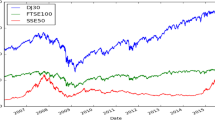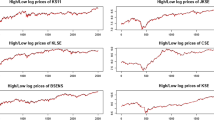Abstract
Using the daily data on SENSEX and NASDAQ from January to October of 2000, the paper attempts to find out to what extent the “news” on NASDAQ helps price formation at the beginning and at the end of a trading day at the Indian bourses. The possible impact of NASDAQ on SENSEX is analyzed through OLS equations under cointegration and error correction framework. The results indicate that the “news” on NASDAQ plays an important role in price formation at the beginning of a trading day at the Indian bourses. However, as the impact of NASDAQ fades a lot during the trading hours when the Indian market remains open and the US market remains closed, the closing figures at SENSEX could not be predicted well with this information.
Similar content being viewed by others
References
Aburachis A. T., (1993), ‘International Financial Markets Integration: An Overview’, in “International Financial Market Integration” by Stansell S. R. (Ed.), Blackwell Publishers, Cambridge, USA, pp. 26–42.
Baillie R. T. and T. Bollerslev, (1989), ‘Common Stochastic Trends in a System of Exchange Rates’, Journal of Finance, 44, pp. 167–181.
Chan K. C. and P. Lai, (1993), ‘Unit Root and Cointegration Tests of World Stock Prices’ in “International Financial Market Integration” by Stansell S. R. (Ed.), Blackwell Publishers, Cambridge, USA, pp. 278–287.
Chatfield C., (1989), “The Analysis of Time Series - An Introduction”, Fourth Edition, Chapman Hall (First Edition was published in 1975).
Chitre V., (1997), ‘Foreign Capital Flows and Financial Markets in India’, Journal of Foreign Exchange and International Finance, 10, pp. 275–282.
Dickey D. and W. A. Fuller, (1979), ‘Distribution of the Estimators for Auto-regressive Time Series with a Unit Root’, Journal of the American Statistical Association, 74, pp. 427–431.
Dickey D. and W.A. Fuller, (1981), ‘Likelihood Ratio Statistics for Auto-Regressive Time Series with Unit Root’, Econometrica, Vol. 89, No. 4, July, pp. 1052–72.
Dwyer G. P. and R. W. Hafer, (1993), ‘Are National Stock Markets Linked ?’, in “International Financial Market Integration” by Stansell S. R. (Ed.), Blackwell Publishers, Cambridge, USA, pp. 235–258.
Engle R. F. and C. W. J. Granger, (1987): ‘Cointegration and Error Correction: Representation, Estimation, and Testing’, Econometrica, 55, pp. 251–276.
Eun C. S. and S. Shim, (1993), ‘International Transmission of Stock Market Movements’ in “International Financial Market Integration” by Stansell S. R. (Ed.), Blackwell Publishers, Cambridge, USA, pp. 259–277.
Gupta L. C., (1997), “India’s Stock Market Crisis”, Society for Capital Market Research and Development, Research Monograph No. 5, Vivek Financial Focus Limited.
Johansen S., (1988), ‘Statistical Analysis of Cointegration Vectors’, Journal of Economic Dynamics and Control, 12, pp. 231–254.
Koch P. D. and T. W. Koch, (1993), ‘Dynamic Relationships among the Daily Levels of National Stock Indexes’, in “International Financial Market Integration” by Stansell S. R. (Ed.), Blackwell Publishers, Cambridge, USA, pp. 299–328.
Krishnan B. and S. S. Narta, (1997), “Security Markets in India”, Kanishka Publishers, New Delhi.
Ma C. M., (1993), ‘Financial Market Integration and Cointegration Tests’ in “International Financial Market Integration” by Stansell S. R. (Ed.), Blackwell Publishers, Cambridge, USA, pp. 288–298.
Mackinon J. G., (1991), ‘Critical Values for Cointegration Tests’ in “Long-Run Economic Relationships: Readings in Cointegration” by Engle R. F. and C. W. J. Granger (Ed.), Oxford University Press, pp. 267–276.
Misra B. M., (1997), ‘Fifty Years of the Indian Capital Market’, Reserve Bank of India Occasional Papers, 18, pp. 351–384.
Phillips P. C. B., (1987), ‘Time Series Regression with a Unit Root’, Econometrica, 55, pp. 277–301.
Phillips P. C. B. and P. Perron, (1988) ‘Testing for a Unit Root in Time Series Regression’, Biometrica, 75, pp. 335–346.
Reserve Bank of India, (2000) “Annual Report”, Reserve Bank of India.
Schollhammer H. and O. C. Sand, (1987) ‘Lead-lag Relationships among National Equity Markets: An Empirical Investigation’ in “Recent Developments in International Banking and Finance” by Khowy S. and A. Ghosh (Ed.), Vol-I, Lexington, KY: Lexington Books.
Sims C. A., (1980) ‘Macroeconomics and Reality’, Econometrica, 48, pp. 1–48.
Stansell S. R., (1993) (Ed.): “International Financial Market Integration”, Blackwell Publishers, Cambridge, USA.
Stock J., (1987), ‘Asymptotic Properties of Least Squares Estimators of Cointegrating Vectors’, Econometrica, 55, pp. 1035–1056.




